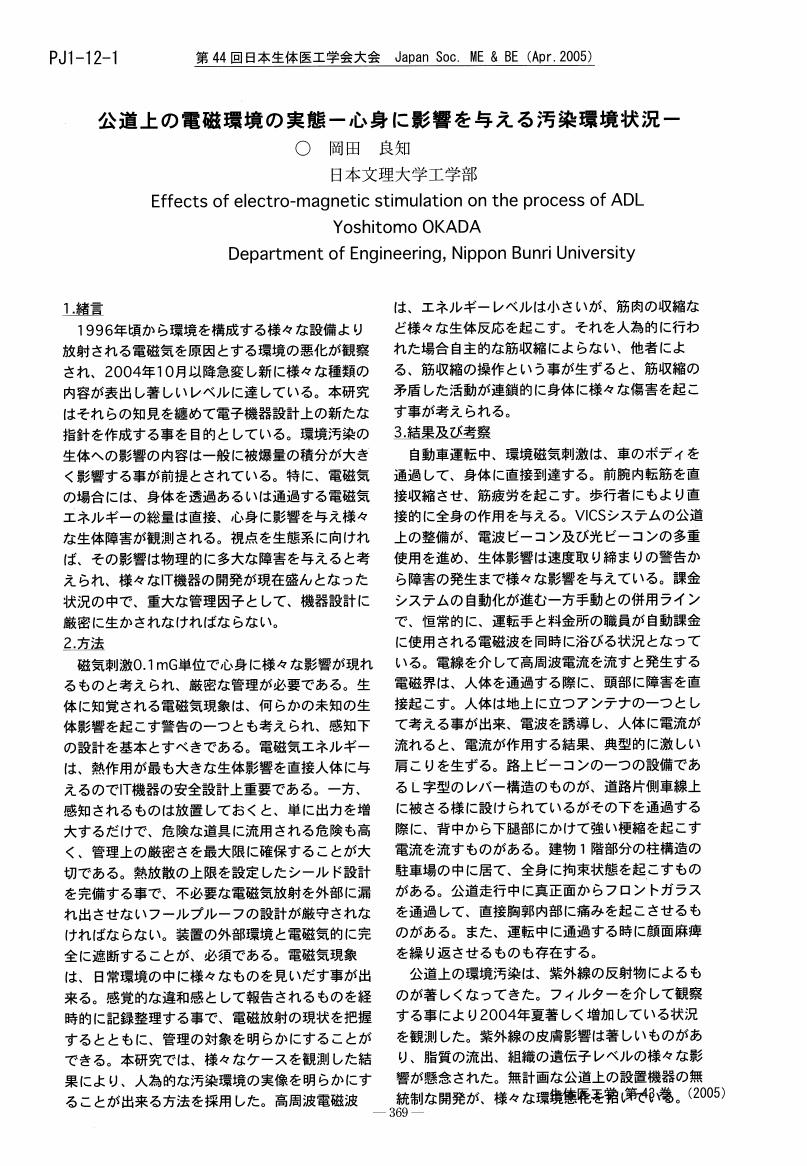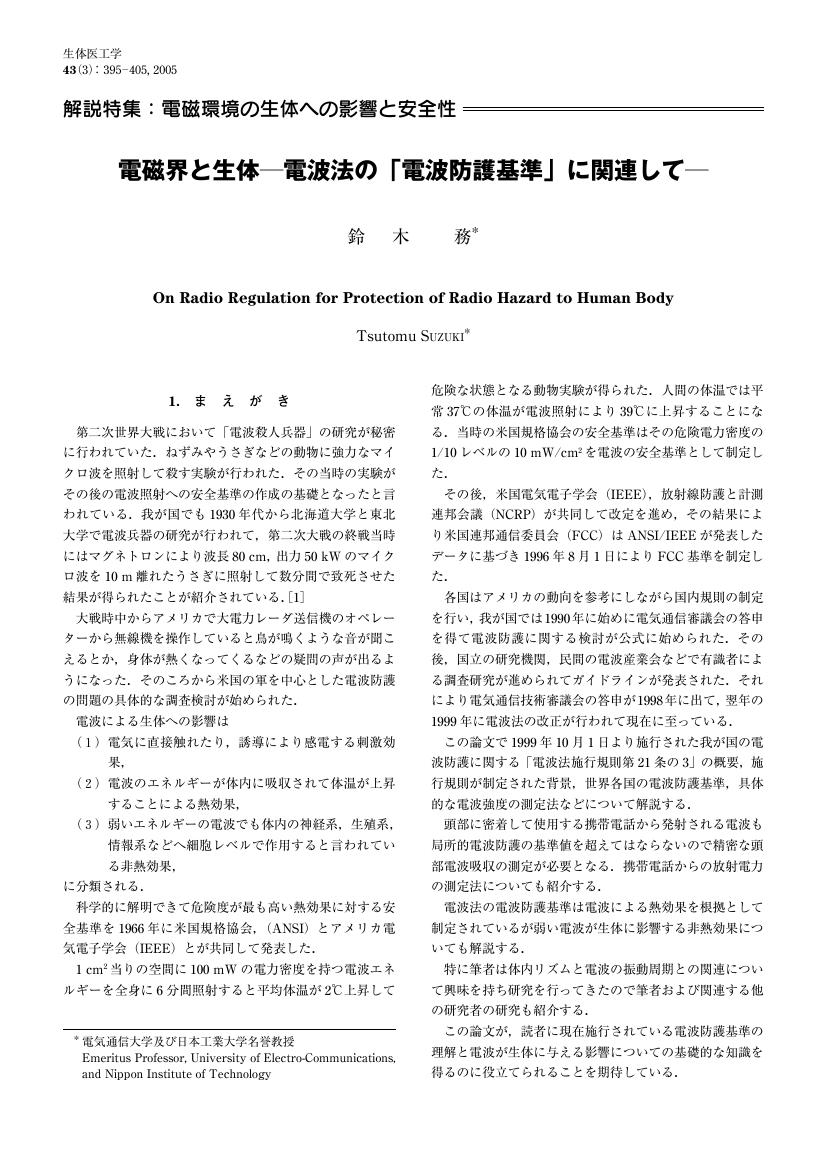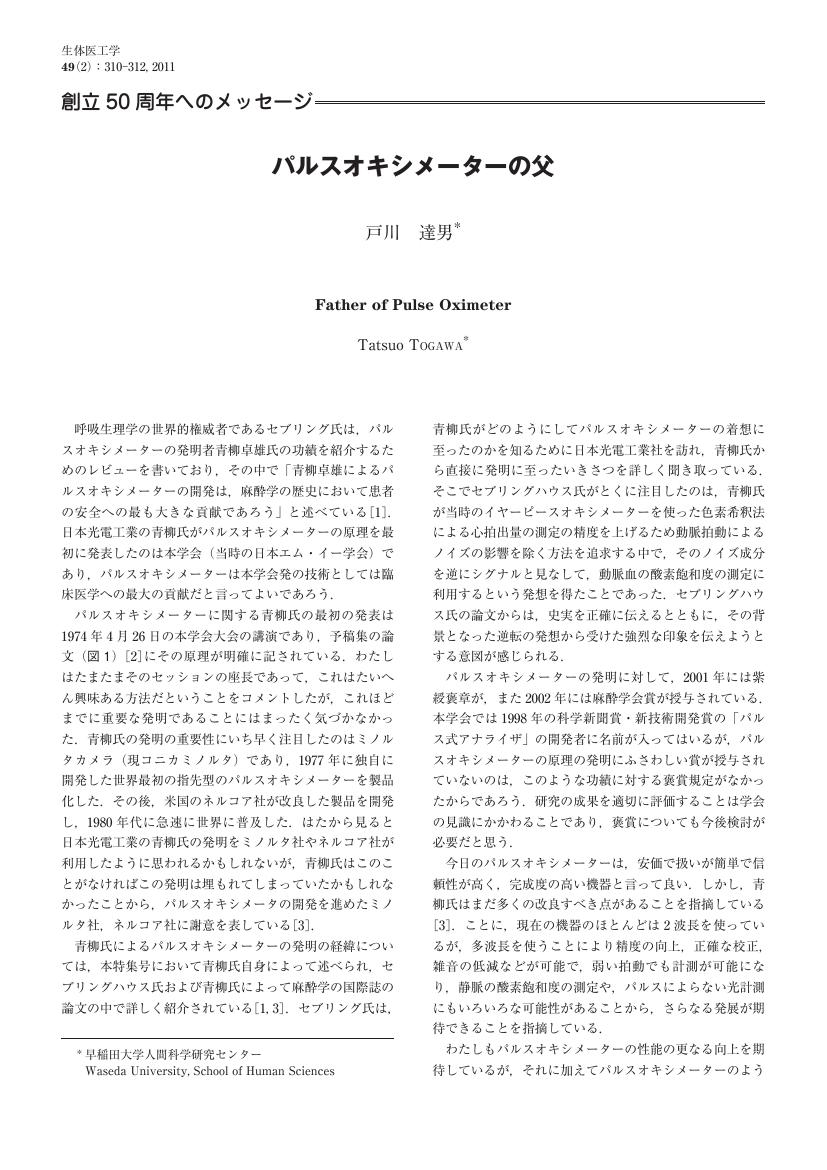104 0 0 0 OA ポスターセッション 電磁界の生体影響
- 出版者
- 公益社団法人 日本生体医工学会
- 雑誌
- 生体医工学 (ISSN:1347443X)
- 巻号頁・発行日
- vol.43, no.Supplement1, pp.369-378, 2005-04-25 (Released:2011-09-05)
30 0 0 0 OA 電磁界と生体―電波法の 「電波防護基準」 に関連して―
- 著者
- 鈴木 務
- 出版者
- 公益社団法人 日本生体医工学会
- 雑誌
- 生体医工学 (ISSN:1347443X)
- 巻号頁・発行日
- vol.43, no.3, pp.395-405, 2005 (Released:2007-01-19)
- 参考文献数
- 6
- 被引用文献数
- 1
27 0 0 0 OA ロボットスーツHALによる脳性麻痺患者の歩行支援に関する研究
- 著者
- 武富 卓三 山海 嘉之
- 出版者
- 公益社団法人 日本生体医工学会
- 雑誌
- 生体医工学 (ISSN:1347443X)
- 巻号頁・発行日
- vol.50, no.1, pp.105-110, 2012-02-10 (Released:2012-07-13)
- 参考文献数
- 7
- 被引用文献数
- 2
The purpose of this study is to propose a method of a walking assistance by using an exoskeletal system “Hybrid Assistive Limb (HAL)” for cerebral palsy (CP) patients who cannot stand up and walk due to the abnormal generation of the bioelectrical signals (BES) in their lower limbs associated with the brain disease, and to verify the effectiveness of the proposed method through a clinical trial. HAL was developed to support the voluntary movement of the wearer based on the BES. The proposed method consists of two algorithms, that is, an assistance of voluntary movement in the swing phase and an assistance of weight bearing in the stance phase. The assistance of the voluntary movement determines the rotational direction of the actuator from the ratio of the abnormal BES by using sigmoid function during the swing phase. On the other hand, the assistance of the weight bearing adjusts automatically the stiffness and viscosity of the joint during the stance phase. In the clinical walking trial with a 3-meter walk using parallel bars, we confirmed that HAL including the proposed method achieved the patient's walking assistance. Especially, the assistance of the voluntary movement in the swing phase produced his leg-swing based on the BES signals. As a result, the walking speed, cadence and stroke width of the patient with HAL during this trial are 1.6m/min, 11.4 steps/min and 0.14m, respectively. In conclusion, we have proposed the method of the walking assistance method and thus, confirmed the effectiveness of the proposed method.
15 0 0 0 OA 嚥下調整食の炭酸強度や温度の違いによる誤嚥防止効果の定量的評価方法
- 著者
- 可児 雅弥 本橋 由香 奥 知子 山内 忍 佐藤 敏夫 阿岸 鉄三
- 出版者
- 公益社団法人 日本生体医工学会
- 雑誌
- 生体医工学 (ISSN:1347443X)
- 巻号頁・発行日
- vol.Annual57, no.Abstract, pp.S90_1, 2019 (Released:2019-12-27)
【目的】嚥下反射の惹起性が低下した患者に対して冷圧刺激法などの冷感刺激を利用したリハビリテーションが実施されており、近年では冷却炭酸水の有用性が注目されている。一方で、食塊の送り込み能力が低下した患者にはゼリー食などの嚥下調整食を用いて誤嚥を予防している。今回の報告では、炭酸水やゼリー食嚥下時の嚥下音を測定・解析し、こられの予防策を効果的に用いる手法について検討した。【方法】嚥下試料として炭酸強度の異なる3種類の炭酸水およびゲル化剤添加量の異なる5種類の水ゼリーを作製した。炭酸水は市販の炭酸水メーカを使用して作製し、ボトル内の圧力値に基づいて炭酸強度を管理した。また、各試料の温度は10℃、20℃、30℃となるように調整した。各試料嚥下時の嚥下音は被験者の舌骨直上および輪状軟骨直下気管外側上に装着した心音センサから採取し、合成嚥下音信号の包絡線から嚥下機能の指標となるP値を算出した。【結果及び考察】P値を算出した結果、炭酸水は炭酸強度が強いほど、また温度が低いほど嚥下反射を惹起させ得る可能性が示唆された。また、硬さが約4100Paのゼリー食が誤嚥を効果的に防止できる可能性が示唆された。
15 0 0 0 OA 睡眠関連ホルモンの計測
- 著者
- 田ヶ谷 浩邦
- 出版者
- 公益社団法人 日本生体医工学会
- 雑誌
- 生体医工学 (ISSN:1347443X)
- 巻号頁・発行日
- vol.46, no.2, pp.169-176, 2008-04-10 (Released:2008-10-06)
- 参考文献数
- 55
- 被引用文献数
- 4
15 0 0 0 OA パルスオキシメーターの父
- 著者
- 戸川 達男
- 出版者
- 公益社団法人 日本生体医工学会
- 雑誌
- 生体医工学 (ISSN:1347443X)
- 巻号頁・発行日
- vol.49, no.2, pp.310-312, 2011-04-10 (Released:2011-12-14)
- 参考文献数
- 3
12 0 0 0 OA 医工連携による致死性不整脈メカニズム解明への取り組み
- 著者
- 稲田 慎 相庭 武司 原口 亮 芦原 貴司 草野 研吾 清水 渉 池田 隆徳 中沢 一雄
- 出版者
- 公益社団法人 日本生体医工学会
- 雑誌
- 生体医工学 (ISSN:1347443X)
- 巻号頁・発行日
- vol.54Annual, no.28AM-Abstract, pp.S264-S264, 2016 (Released:2016-11-19)
Our research group have been conducting simulation studies for analyzing arrhythmia such as sick sinus syndrome, atrial fibrillation, ventricular tachycardia and fibrillation using multi-scale heart models with personal computer and supercomputer. One purpose of our simulation studies is to stratify the arrhythmic risk non-invasively using computer simulation. Recent study has shown that conduction delay around the right ventricular outflow tract is one of the mechanisms to induce ventricular arrhythmias such as Brugada syndrome. Our findings from computer simulation suggest that our model may be useful to stratify the arrhythmic risk in the Brugada syndrome. In this symposium, we will present our simulation scheme and recent progresses. In addition, we would like to discuss our future prospect and the possibility of computer simulation.
12 0 0 0 OA 日本医療機器産業の活性化のために
- 著者
- 匿名A
- 出版者
- 公益社団法人 日本生体医工学会
- 雑誌
- 生体医工学 (ISSN:1347443X)
- 巻号頁・発行日
- vol.46, no.3, pp.328-329, 2008-06-10 (Released:2008-10-31)
11 0 0 0 OA 透析低血圧への一時的対処法に関する基礎的検討
- 著者
- 山下 政司 相川 武司 北間 正崇
- 出版者
- 公益社団法人 日本生体医工学会
- 雑誌
- 生体医工学 (ISSN:1347443X)
- 巻号頁・発行日
- vol.55, no.2, pp.84-90, 2017-04-10 (Released:2017-05-23)
- 参考文献数
- 21
During hemodialysis, blood pressure decreases to a state of hypotension in some patients, and temporary measures to increase blood pressure are given. Typically, fluid replacement, medication, and passive leg raising are used. As each strategy has pros and cons, we attempted to find simple and fast-acting measures. Fifteen healthy men participated in this study. Continuous blood pressure, electrocardiograms, stroke volume, and plethysmograms were obtained at various time intervals. The protocol consisted of 15 min of acclimation in a supine position, resting for 5 min, performance of one of the methods to increase blood pressure for 5 or 15 min, and then resting for 1 min. This protocol was performed repeatedly for different methods in random order. The following methods were selected:passive one-leg-bending exercise (5 min), using a leg massage machine (15 min), applying medical stocking (15 min), and talking (5 min). Systolic blood pressure increased significantly only for talking. Diastolic blood pressure also tended to increase for talking, although not significantly. Further, heart rate increased significantly for talking only. Heart rate increased temporarily for passive one-leg-bending exercises for 5 min. Stroke volume tended to decrease for all the methods but not for control. Total peripheral resistance, which was calculated from blood pressure, stroke volume and HR, increased significantly for using a massage machine at the beginning of massage. Pulse wave amplitude tended to decrease for talking. Overall, talking increased heart rate and consequently increased systolic blood pressure, although none of the methods increased stroke volume. These results identified talking as a feasible and fast-acting method to manage hypotension during dialysis.
9 0 0 0 OA 人体通電の影響と安全基準
- 著者
- 吉元 俊輔 青山 一真 梶本 裕之 西川 敦
- 出版者
- 公益社団法人 日本生体医工学会
- 雑誌
- 生体医工学 (ISSN:1347443X)
- 巻号頁・発行日
- vol.58, no.4-5, pp.147-159, 2020-09-10 (Released:2020-10-30)
- 参考文献数
- 46
Studies about electrical current passing through the body such as bioelectricity measurement, electrical excitation, and electrical stimulus have contributed to the field of medical and biological engineering. To evaluate the applicability of the Clinical Trials Act, stimulus conditions are needed to be designed based on the understanding of safety criteria provided by various organizations, as well as the effects of the electricity applied to the human body. Because electrical current causes various effects such as perception, pain, injury, and fibrillation, safety design is essential. This paper summarizes the effects and safety criteria of the electricity applied to the human body based on the available guidelines. Furthermore, effects and criteria of the electricity applied to the head are discussed. Finally, we present an example of the stimulus evaluation to confirm the applicability of the Clinical Trials Act.
8 0 0 0 OA 便座心電図を用いた個人識別の基礎的研究
- 著者
- 中川 新太 金 主賢 中島 一樹
- 出版者
- 公益社団法人 日本生体医工学会
- 雑誌
- 生体医工学 (ISSN:1347443X)
- 巻号頁・発行日
- vol.56, no.5, pp.183-189, 2018-10-10 (Released:2019-03-07)
- 参考文献数
- 28
- 被引用文献数
- 3
In order to achieve health management and disease prevention, many studies of toilets with sensors have been conducted to measure daily physiological information. These studies require person identification, assuming that several people use the same toilet. In this study, we focused on the identification of a person while sitting on a toilet seat. Three electrodes were attached to the toilet seat, and identification was performed using an electrocardiogram recorded from both thighs. The aim of this study was to investigate the usefulness of the proposed person identification method. We calculated the identification rate and equal error rate (EER) for the proposed person identification method. Fifty thigh electrocardiogram samples were obtained from 5 subjects. In addition, an electrocardiogram was simultaneously recorded from the chest of each subject. The R wave, S wave, and T wave were clearly obtained from both electrocardiograms. The peak/negative peak times of R, S, and T waves recorded from both thighs correlated with those measured simultaneously from the chest. Eleven features including amplitude and interval were extracted from the thigh electrocardiogram. Discriminant analysis using Mahalanobis distance was performed to calculate the identification rate. The average identification rate was found to be 82%. Furthermore, the EER, which is an accuracy evaluation index for person identification, was calculated. The average of EER was found to be 15.8%.
8 0 0 0 OA パルスオキシメトリの誕生とその後
- 著者
- 青柳 卓雄
- 出版者
- 公益社団法人 日本生体医工学会
- 雑誌
- 生体医工学 (ISSN:1347443X)
- 巻号頁・発行日
- vol.49, no.2, pp.313-315, 2011-04-10 (Released:2011-12-14)
- 参考文献数
- 5
8 0 0 0 OA マイクロ波を用いた睡眠深度のセンシング
- 著者
- 岡田 志麻 北川 将嗣 山本 康平 橘 素子 前野 蔵人
- 出版者
- 公益社団法人 日本生体医工学会
- 雑誌
- 生体医工学 (ISSN:1347443X)
- 巻号頁・発行日
- vol.54, no.3, pp.139-144, 2016-06-10 (Released:2016-11-23)
- 参考文献数
- 16
Sleep is essential for the maintenance of human life. Polysomnography (PSG) is a common method for the evaluation of sleep quality. However, the test requires attachment of many electrodes to the subject, and the constraint may cause great stress. Therefore, it is important to find a new method to free the subject from being burdened by electrodes;that is, to measure in an unconstraint and noncontact manner. In this study, we propose a new sleep measurement system using microwave sensing. The sensor detects body movements and respiratory movements in a noncontact manner. In this study, we analyzed sleep stage using PSG and simultaneously measured body movements and respiratory movements using a radio-frequency sensor. The mean and standard deviation of the number of body movements decreased, and the movements also became micro-movements when the degree of awakening decreased. The mean respiratory frequency did not change markedly in various sleep stages and showed little dispersion. The mean and standard deviation of the respiratory amplitude decreased as was observed for body movement, and the respiratory amplitude was stable when the degree of awakening decreased. We used the linear discriminant function to classify the sleep stages into:Wake, REM, Light and Deep sleep. The mean agreement rate was approximately 78% for four stages in total. Our results show that the sleep stages can be successfully estimated by body and respiratory movements during sleep.
7 0 0 0 OA 市販光学式心拍計における心拍数計測信頼性評価
- 著者
- 田河 賢治 木下 賢吾
- 出版者
- 公益社団法人 日本生体医工学会
- 雑誌
- 生体医工学 (ISSN:1347443X)
- 巻号頁・発行日
- vol.55Annual, no.Proc, pp.601-602, 2017-05-03 (Released:2017-09-13)
- 参考文献数
- 2
Motivation: Over the past few years, activity trackers which can measure everyday steps, energy expenditures, and sleeping time are getting popular. Especially these days, some activity trackers use not only accelerometers but also optical heart rate monitors based on photopletysmography. In this study, we evaluated reliability of an optical heart rate activity tracker during running.Method and Results: Several subjects(n=11, all male) ran 1km on a flat road and we analyzed heart rate errors to check if there was a difference between subjects. We found that some subjects had significantly higher Mean Absolute Error than others(highest MAE,20.54±13.64; average MAE, 8.41±6.47), and there was a strong correlation between each subject's MAE and the standard deviation of running speed(Pearson's r=0.87, p<0.001).Conclusion: Optical HR monitors lead to errors when users change their pace of running.
6 0 0 0 OA 脳循環と脳脊髄液の流れを統合した動態解析モデル
- 著者
- 山田 茂樹 大島 まり 尹 彰永 伊藤 広貴 渡邉 嘉之 前田 修作 武石 直樹 大谷 智仁 和田 成生 野崎 和彦
- 出版者
- 公益社団法人 日本生体医工学会
- 雑誌
- 生体医工学 (ISSN:1347443X)
- 巻号頁・発行日
- vol.Annual59, no.Proc, pp.764-766, 2021 (Released:2021-10-17)
【背景・目的】閉鎖空間の頭蓋骨内を脳血液がスムーズに灌流するために脳脊髄液が拍動し、脳代謝による老廃物の排泄と放熱のために脳間質液と脳脊髄液が灌流する(グリンファティックシステム)と考えられている。この複雑な脳内の流体の動きを具現化した数理モデルは未だ存在しない。我々は、主要な脳動脈を3Dモデル、その末梢動脈を1Dモデル、さらに細動脈を0Dモデルで結合し、これを全身循環モデルに組み込んだマルチスケール脳循環数理モデルをこれまでに構築しており、このモデルに脳脊髄液の動きを統合したいと考え、現状と課題を報告する。【方法・結果】健常者の3D MRIから形体情報を収集し、4D Flow MRIから3D流速を収集して、3D画像解析ワークステーションで計算する。脳、脳脊髄液腔(脳室・くも膜下腔)と脳血管は、各々の撮影条件でデータ収集が必要であり、現状は統合できないため、それぞれ個別にサーフェイスモデルを作成し、流速情報を3Dモデルの流入・流出境界条件を設定して、CFD解析に用いる必要がある。【結論】心拍に同期した脳脊髄液の3D動態は、脳血液の灌流による脳の拍動が駆動力となっており、脳循環に連動している。新知見を考慮した脳循環と脳脊髄液の動きを統合した動態解析の数理モデルは非常に複雑であり、未だ課題は多い。また、加齢に伴う脳萎縮、脳代謝の低下、動脈硬化は、脳循環と脳脊髄液の動態に大きく影響すると考えられるが、未解明の領域である。
6 0 0 0 OA 4D肺モデルにもとづいた埋め込み型人工肺の設計
- 著者
- 北岡 裕子
- 出版者
- 公益社団法人 日本生体医工学会
- 雑誌
- 生体医工学 (ISSN:1347443X)
- 巻号頁・発行日
- vol.55Annual, no.3AM-Abstract, pp.163, 2017 (Released:2017-09-13)
現在臨床使用されている人工肺には、心臓手術の際に使用される人工心肺と重症呼吸不全の際に用いられる膜型人工肺があるが、どちらも体外型で、移植肺と同じように胸郭内に埋め込む人工肺は全く開発されていない。その理由は、肺胞の構造が微細かつ複雑に過ぎるためと考えられる。演者は第55回本総会で肺胞系における気流血流ガス拡散シミュレーションを発表し、ヒトの酸素需要を賄うのに「テニスコート1面分」の表面積は不要であること、肺胞系の微細構造は弾性復元力を獲得するために必要であることを明らかにした。生体の弾力線維よりも強力な弾性をもつ人工材料を用いれば、実際の肺胞のサイズの20倍程度であっても、安静時の酸素需要を賄うガス交換を達成できる。また、20倍大の人工肺胞であれば、現在体外型人工肺で用いられている中空糸のサイズで肺胞壁内の血流が維持できる。3Dプリンターを用いて作成した人工肺を患者の胸郭に埋め込む方法として、患者の気管支、肺動静脈と人工肺の気管支、肺動静脈を接合させる。そうすると、患者の心拍動により肺循環が成立する。また、人工肺の表面を、患者の胸壁胸膜と密着させると、患者の呼吸運動に追随して人工肺が膨張収縮し、接合した気管支を通して空気が出入りする。つまり、外部からの動力なしで、換気と肺循環が成立する。永続的な埋め込み型人工肺の開発は、医工学研究者が挑戦すべき重要課題と考えられる。
6 0 0 0 OA 蚊の吸血ポンプ特性評価
- 著者
- 菊地 謙次 寺田 信幸 望月 修
- 出版者
- 公益社団法人 日本生体医工学会
- 雑誌
- 生体医工学 (ISSN:1347443X)
- 巻号頁・発行日
- vol.46, no.2, pp.232-237, 2008-04-10 (Released:2008-10-06)
- 参考文献数
- 4
- 被引用文献数
- 1
Many researches and developments have tried to realize a μTAS in several fields, but it has not been realized yet because of a scale effect in the course of miniaturization. It is difficult to make an enough volume of flow in a micro tube. This is a bottleneck of realizing the μTAS. We have tried to apply a unique mechanism of insects to the μTAS devises. In this paper, we focused on a blood-sucking mechanism of a mosquito that can obtain blood at the rate of approximately 1.0 μl/min. To understand the structure of their pumps, we made a mosquito into many slices, and anatomized under a microscope; we also let mosquitoes feed on human blood on a glass plate. We found the following results: 1) a manner of blood sucking, 2) a power density of the pump system by an analysis of flowing red blood cells at a tip of proboscis of mosquito. We have succeeded to reveal the blood-sucking mechanism of the mosquitoes, which can be applied to micro fluid devices.
5 0 0 0 OA 電気刺激を利用した痛み定量計測法の開発と実験的痛みによる評価
- 著者
- 嶋津 秀昭 瀬野 晋一郎 加藤 幸子 小林 博子 秋元 恵実
- 出版者
- 公益社団法人 日本生体医工学会
- 雑誌
- 生体医工学 (ISSN:1347443X)
- 巻号頁・発行日
- vol.43, no.1, pp.117-123, 2005 (Released:2007-01-19)
- 参考文献数
- 14
- 被引用文献数
- 4
We have developed a method and a system to quantitatively evaluate human pain without relying on subjective criteria. The concept of pain quantification is to compare the magnitude of the subject's pain to the magnitude of a painless electric stimulus that is comparable to actual pain. We quantified degree of pain as the pain ratio, based on the ratio between pain equivalent current and minimum perceived current. In the system developed as the objective of this study, a gradually increasing pulsed current (frequency was 50 Hz, and the pulse width was 0.3 ms) was applied to the subject's medial forearms, and the subjects compared the magnitude of this sensation to electrical stimulation produced by an electrical current. Using test equipment, we conducted basic evaluations of measurement principles. We induced two types of experimental pain, by applying weight load to the upper arm and the lower leg, and by pinching the skin using clips. We examined whether changes in the degree of sensation with respect to electrical stimulation used in this method could be accurately observed, and whether or not it was possible to accurately and with high reproducibility measure minimum perceived current and pain equivalent current. As a result, we were able to make a clear comparison between pain and the degree of stimulation by electrical current, which was a sensation differing from pain. Although there were individual differences in the measured values, the reproducibility of the pain equivalent current as measured was favorable, and the measured values for pain ratio were also reproducible. We confirmed in the present study that the degree of experimental pain can be expressed as quantitative numerical values using an index defined as pain ratio.
5 0 0 0 OA いまさら聞けない信号処理
- 著者
- 小野 弓絵
- 出版者
- 公益社団法人 日本生体医工学会
- 雑誌
- 生体医工学 (ISSN:1347443X)
- 巻号頁・発行日
- vol.57, no.2-3, pp.75-80, 2019-06-10 (Released:2019-08-20)
- 参考文献数
- 7
Digital signal processing is one of the fundamental technologies utilized in the field of biomedical engineering. Typical purposes of digital signal processing are acquisition and analysis of biological signals, noise reduction and extraction of the required signals, and identification of biological systems. This introductory article provides some basic ideas and techniques of digital signal processing in biomedical engineering:biosignal sampling, spectrum analysis, and filter design.
4 0 0 0 OA 24時間の自律神経活動リズム
- 著者
- 清水 徹男
- 出版者
- 公益社団法人 日本生体医工学会
- 雑誌
- 生体医工学 (ISSN:1347443X)
- 巻号頁・発行日
- vol.46, no.2, pp.154-159, 2008-04-10 (Released:2008-10-06)
- 参考文献数
- 31






